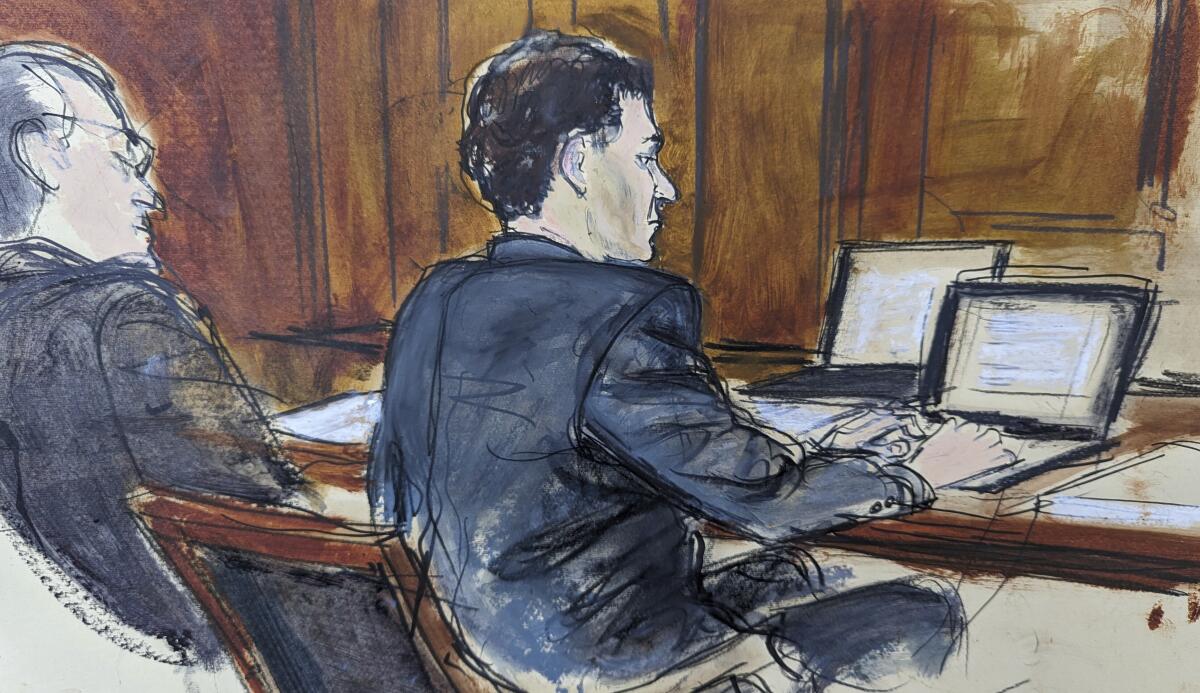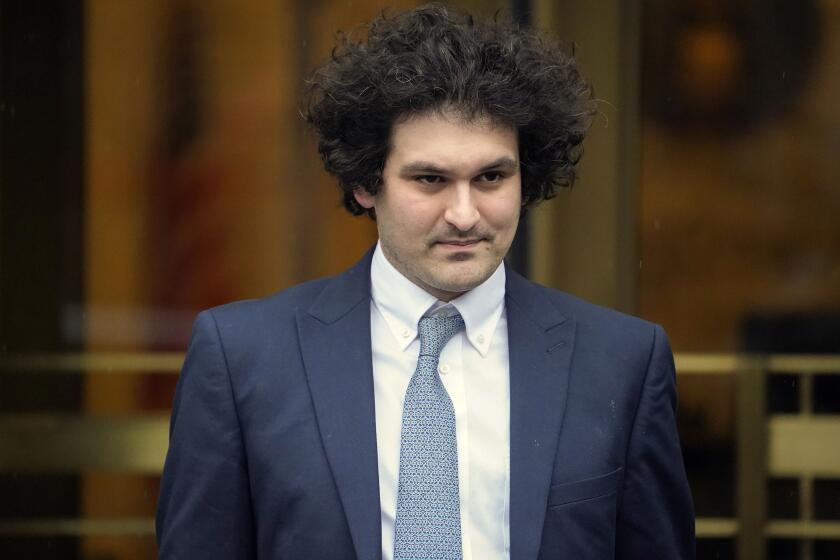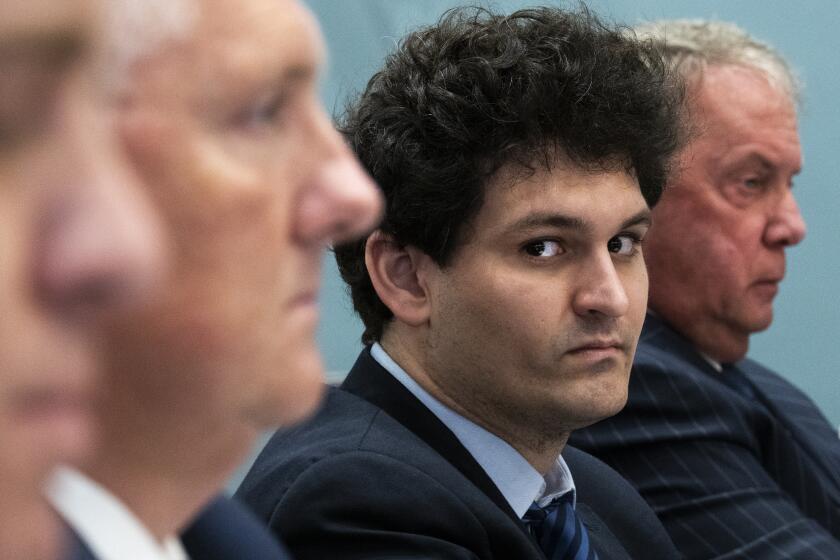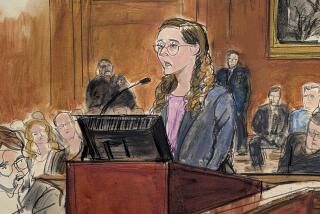Sam Bankman-Fried ‘lied to the world’ as he built crypto empire, prosecutors say

- Share via
Sam Bankman-Fried “lied to the world” as he built his cryptocurrency empire at FTX, telling only his friends and girlfriend the truth about what was happening, prosecutors said on the first day of a historic fraud trial.
Nathan Rehn, an assistant U.S. attorney, painted a picture of the 31-year-old as a calculated criminal who used investor deposits at FTX as a personal bank account before the company collapsed into bankruptcy a year ago. He said that only Bankman-Fried’s small inner circle knew that he was taking customer money to fund his lifestyle.
“He had wealth, he had power, he had influence, but all of that was built on lies,” Rehn told jurors in federal court in Manhattan Wednesday. “He was committing a massive fraud, and taking billions of dollars from thousands of victims.”
Prosecutors included several references to former Alameda Research co-chief executive Caroline Ellison in their opening statements, as one of the individuals that knew what was going on behind the scenes. Ellison, Bankman-Fried’s former girlfriend, is the government’s star witness after reaching a cooperation deal last year. Gary Wang, former FTX chief technology officer and Nishad Singh, FTX’s former engineering director, are also expected to take the stand as cooperating witnesses.
The case, which the government has labeled one of the biggest financial crimes in the country’s history, will explore how an awkward 20-something from California came to run and allegedly ruin one of the largest crypto exchanges in the world. The MIT graduate faces a maximum prison term of 20 years for each of the five most serious charges against him.
The ridiculous story of Sam Bankman-Fried, FTX and cryptocurrency generally is aired in two new books, but only one is worth reading and it’s not by bestselling author Michael Lewis.
Bankman-Fried was expressionless as Rehn spoke, but briefly looked at the jury as the government lawyer emphasized “billions of fraud,” before turning back to stare at his laptop. The former crypto executive’s parents, a pair of Stanford University law professors, sat in the gallery behind their son.
‘Cartoon villain’
Bankman-Fried’s lawyers said that Rehn portrayed their client as a “cartoon” villain, rather than the math nerd he truly was.
“The evidence will give you different context — that Sam works very hard, didn’t drink or party, and went to MIT,” his lawyer, Mark Cohen, said during his opening arguments. “Sam didn’t intend to defraud anyone. There was no theft.”
Cohen said that the “rise and fall” of FTX, and Alameda Research, an affiliated hedge fund, mirrored the wider crypto industry, which was battered by fast-changing market conditions in 2022.
“The case in many ways is about crypto from 2017 to 2022,” Cohen said. “You will learn that crypto is not for everyone.”
Michael Lewis’ latest book, ‘Going Infinite,’ on Sam Bankman-Fried and the rise and fall of FTX, is well-timed, unsatisfying and surprisingly confusing.
Bankman-Fried is accused of taking customer funds from FTX and using them to engage in speculative trading through Alameda. Cohen said their client had “reasonably believed” that loans provided by Alameda were permitted and backed by collateral.
Cohen explained that FTX grew to have 350 employees, that a risk management team was not yet built and that Bankman-Fried and others executives made hundreds of decisions a day, which mean that “some things were overlooked.”
“Running a startup was like building a plane while you’re flying it,” he said.
John Reed Stark, a former SEC enforcement attorney and crypto critic, said on the social media platform X, formerly known as Twitter, that the prosecution’s “stockpile of cooperating prosecution witnesses is arguably unprecedented for a financial fraud trial.”
“For the past year or so, these three informants together with a legion of other informants, turncoats and whistleblowers (who are also similarly desperate to save their own skin), have been providing the prosecution with a roadmap of SBF’s alleged criminal activities,” said Stark, who now runs his own consulting company.
Sam Bankman-Fried wanted to make cryptocurrency look legitimate. He only added to the evidence that it’s not to be trusted.
The company’s terms of service as well as old Bankman-Fried tweets ensuring customers that their money was safeguarded were among the examples Rehn touched upon to indicate to the jury that FTX engaged in fraud.
Rehn said that FTX misleadingly told customers that the money belonged to them, not the company. “FTX’s advertising slogan was about how customers could trust it,” he said.
He made reference to a Bankman-Fried tweet — “FTX has a long history of safeguarding assets and that remains true today.”
“Statements about FTX keeping customer money safe were lies,” Rehn said.
More to Read
Inside the business of entertainment
The Wide Shot brings you news, analysis and insights on everything from streaming wars to production — and what it all means for the future.
You may occasionally receive promotional content from the Los Angeles Times.













